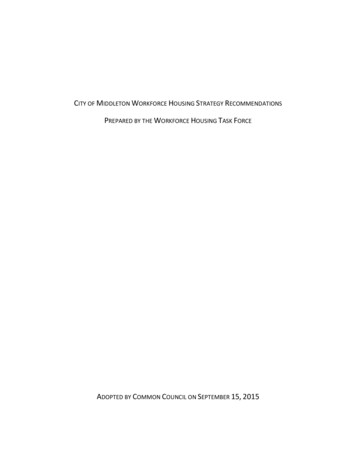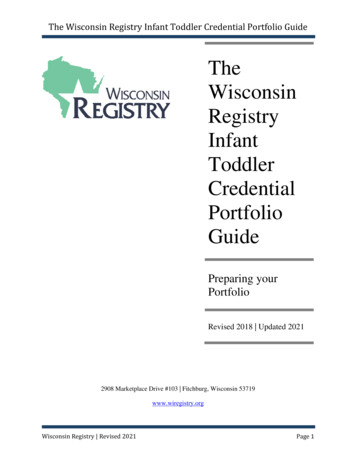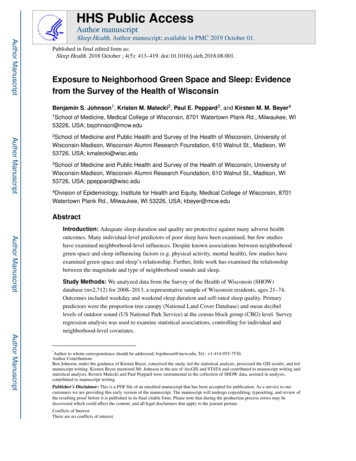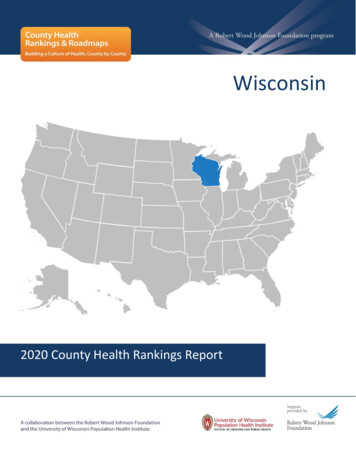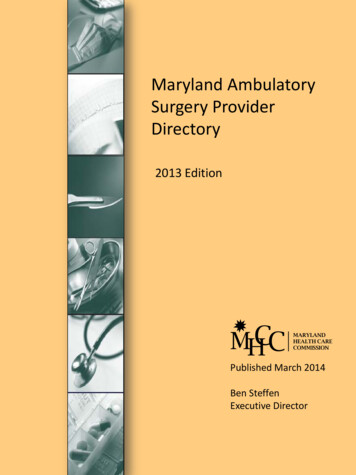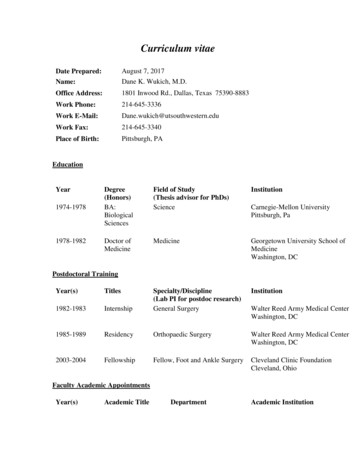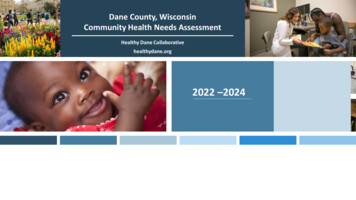
Transcription
Dane County, WisconsinCommunity Health Needs AssessmentHealthy Dane Collaborativehealthydane.org2022 –2024
Greetings,Message totheCommunityDane County has a unique history of collaboration between local health careproviders. For many years, our organizations have worked together in order toleverage our combined resources and address the health concerns of our community.In 2012, members of the Dane County Health Council came together to develop a jointhealth needs assessment under the name Healthy Dane Collaborative. Since thedevelopment of the 2012 Community Health Needs Assessment (CHNA), the HealthyDane Collaborative continues to work together to pursue collaborative approachesaimed at improving the health of Dane County.This 2022-2024 CHNA was collaboratively completed in 2021 by Healthy Danepartners: Group Health Cooperative, Public Health Madison Dane County, SSM HealthSt. Mary’s, Stoughton Health, UnityPoint Health-Meriter and UW Health. It combinespopulation health data in addition to feedback gathered from the community throughcommunity input sessions and interviews to present a big-picture view of the factorsimpacting the health of our community. While many indicators of health are positiveoverall, it is apparent that specific populations in Dane County, specifically Black,Indigenous, and People of Color, experience significant inequities in terms of socialand economic opportunities and health outcomes.The Healthy Dane Collaborative recognizes the health needs of the community and theresources available are constantly evolving. The CHNA can serve as a valuableguidepost to establish shared priorities and as a benchmarking tool as we continue tocreate a healthier Dane County. The Healthy Dane Collaborative is proud to share thisCHNA with the community.Sincerely,UW Health, SSM Health St. Mary's, UnityPoint Health – Meriter, Stoughton Health,Group Health Cooperative SCW, and Public Health Madison Dane County
Healthy DaneCollaborativePartners
Table of Contents:Executive SummarySection 1: Communities Served 1.1: History of the Land1.2: Data Profile of the Communities ServedSection 2: Framework for Assessment 2.1: Frameworks2.2: Methodology2.3: Data Limitations2.4: Summary ThemesSection 3: Health Factors Section 4: Youth Welfare 4.1: Health Outcomes4.2: Health Behaviors4.3: Social & EconomicSection 5: Older Adult (65 ) Welfare 5.1: Health Outcomes5.2: Health Behaviors5.3: Clinical Care5.4: Social & EconomicPages 153-154: Additional ResourcesPage 155: Acknowledgements3.1: Health Outcomes3.2: Health Behaviors3.3: Clinical Care3.4: Social & Economic3.5: Physical Environment4
Executive SummaryHealthy Dane is a community collaborative comprised of 4 Dane County hospitals (UnityPoint Health – Meriter, SSM Health St. Mary's Hospital –Madison, Stoughton Health, and UW Health), Group Health Cooperative – South Central Wisconsin and Public Health Madison and Dane County.The group came together to assess community health needs. The members of Healthy Dane have a long history of collaboration particularlyaround issues affecting access to healthcare.The development of Healthy Dane is another example of how area hospitals and the local health department work together to improve thehealth of all Dane County residents. The group recognizes that health issues that are identified in this assessment may be larger and morecomplex than one organization can address. We are committed to working together, along with other Dane County partners and residents, tounderstand and address the needs of the community in coordinated and effective ways.This community health assessment included significant input from the community and a detailed examination of public health data. Communityinput was collected through a community health survey that was made available in English, Spanish and Hmong and through virtual and inperson community input sessions and key informant interviews. An additional healthcare provider survey gathered additional input and insightsfrom healthcare providers about the health needs and challenges of their patients. Much secondary data was examined to further explore andunderstand health needs and impediments to good health. Most data came from healthydane.org which utilizes data fromthe National Cancer Institute, the Environmental Protection Agency, U.S. Census Bureau, the U.S. Department of Education, as well as othernational, state and regional sources.This assessment included data and findings from the 2021 Dane County Youth Assessment (DCYA). The DCYA is a collaborative effort led by theDane County Youth Commission in partnership with the United Way of Dane County, Public Health Madison & Dane County, the City of Madison,and public and private schools in Dane County. Since 1980, Dane County youth in grades 7-12 have been surveyed regarding their experiencesat home, in school and in their communities. Survey topics include alcohol/drug use, level of school engagement, use of free time, health andnutrition, mental health, family relationships, and risk behaviors. DCYA data offers a comprehensive profile of the needs and interests of DaneCounty youth. In 2021, 26,993 youth completed the survey.
Section 1: CommunitiesServed6
1.1: History ofthe LandThe Ho-Chunk Nation, People of the Big Voice, havelong occupied land in Wisconsin extending fromGreen Bay beyond Lake Winnebago to theWisconsin River and even to the Rock River inIllinois amounting to 8.5 million acres.Due to lead mining in the late 1820s, the Ho-Chunkwere forced to leave Wisconsin and sell their landto the U.S. Government. Over time, many returnedto Wisconsin and had to repurchase tribal landsthat they once owned including areas in DaneCounty.Healthy Dane wishes to acknowledge that DaneCounty is on ancestral land that has long beenhome to the Ho-Chunk Nation.
1.2: Data Profile of theCommunities ServedHealthy Dane Collaborative Selected Dane County as the community of focus for this needsassessment. The county is the primary service area for most of the patients served by ourhealth systems. The county is nearly 1,200 square miles of urban, suburban, and rural communities. Although Dane County has approximately 572,000 acres (about 72% of the total land) inagricultural use, Dane County is classified by the United States Census, Bureau as ametropolitan area. Four of the health systems are in the metropolitan area while one (Stoughton) is in a ruralarea. Over 23,000 middle and high school youth participants.Belleville School District, Cambridge School District, De Forest Area SchoolDistrict, Deerfield Community School District, Edgewood High School,Madison Metropolitan School District, Marshall School District, McFarlandSchool District, Middleton-Cross Plains School District, Monona GroveSchool District, Mount Horeb Area School District, Oregon School District,Stoughton Area School District, Sun Prairie Area School District, VeronaArea School District, Waunakee Community School District, WisconsinHeights School District.
1.1: Data Profile of the Communities ServedMadison has 258,054 residents, almost half of the county's population. Among its residents are morethan 47,571 UW students.In addition to being the center for the state and county government, Dane County is also home toWisconsin's flagship public university, the University of Wisconsin-Madison.As a result, educational and health services are the largest industry sub-sector in the county, followed bytrade, transportation and utilities, professional & business services, leisure & hospitality, and publictransportation.
1.2: Data Profile of theCommunities ServedDane County is the second most densely populatedcounty in Wisconsin, and Madison is the second largestcity in the state.The population grew 2.8% between 2016 and 2019,bringing the total population to 546,695.
Section 2: Framework forAssessment11
2.1: FrameworksEnvironmental and social factors greatly impact the health of acommunity.We assessed input from the community and data related toeach of the Health Factors in the County HealthRankings Model to better understand what is impactingthe health of our community.
2.1: FrameworksThe Healthy Dane Collaborative conductedthis Community Health Needs Assessment using a healthequity lens.We are committed to addressing health inequities: “typesof unfair health differences closely linked withsocial, economic, or environmental disadvantages thatadversely affect a group of people.”
Community Health ImprovementCHNACHISOutcomes Tax-exempt hospitals complete a Community Health NeedsAssessment (CHNA) every 3 years to identify priority health issues Following CHNA, required to complete Community HealthImplementation Strategy (CHIS) that includes actions, resources,planned collaboration and anticipated impact. Implement community health implementation strategies andmeasure impact
2.2: Methodology: Qualitative DataKey InformantInterviewsCommunity InputSessions Healthy DaneCollaborativepartnersconducted 10 KeyInformantInterviews. The Key InformantInterviews werecarried out withindividualsknowledgeable ofbroad or specificcommunity healthneeds. Healthy DaneCollaborativepartnersconducted 9CommunityConversations[Focus Groups]with diversegroups. Efforts were madeto gather inputfrom morevulnerable andhistoricallymarginalizedpopulations.Community SurveysProvider SurveyDane County YouthAssessment A CommunityHealth survey wasconducted inEnglish, Spanishand Hmong. 862 individualsfrom Dane Countycompleted thesurvey. 17 individualscompleted theSpanish-languagesurvey, and oneindividualcompleted theHmong-languagesurvey. A survey wasconducted amonghealthcareproviders in thecommunity togather theirperspective onthe needs of theirpatients. 186 Providersparticipated fromthe followingspecialties:pediatrics, familymedicine, generalinternal medicineand obstetricsand gynecology. The Healthy DaneCollaborativepartnersincorporatedfindings of the2021 DaneCounty YouthAssessment(DCYA). The DCYA is asurvey of youth ingrades 7 – 12 thatis completedevery three years. 26,993 studentsparticipated inthe 2021 DCYA.15
Community Partners Engaged Reach Dane Delta Sigma Theta Sorority Inc. Children’s Mental Health Collaborative Road Home Fitchburg Fire Department Hmong Institute Bayview Community Center Vera Court/Bridge Lakepoint Oregon Youth Center Neighborhood Free Health Clinic (Stoughton) Latino Health Council Oceanhawk Counseling African American Opioid Coalition Stoughton Area Resource Team (START) Urban League of Greater Madison Guild Alpha Kappa Alpha Sorority Inc. Madison Links Inc. Madison Network of Black Professionals16
2.2: Methodology: Quantitative DataOur main source of secondary data waswww.healthydane.org. This website ismaintained by Health CommunitiesInstitute and utilizes data available fromthe National Cancer Institute, theEnvironmental Protection Agency, U.S.Census Bureau, the U.S. Department ofEducation, as well as other national, stateand regional sources, to provide asnapshot of the community’s health.Other data sources are cited throughoutthe report (see footnotes).17
2.2: Methodology: Community SurveyThe first survey question asked, “With which category do youidentify?”The second question asked, “What is yourgender identity?”With which categories do you identify?What is your gender frican AmericanAmerican Indian oror BlackAlaskaNativeAsianIndianEast Asian Hispanic or MiddleNativeLatinx Eastern or HawaiianNorthor her18
2.2: Methodology: Community Survey In the Spring of 2021, the Healthy DaneCollaborative developed anddistributed a community health surveyin English, Spanish and Hmong. The 24-question survey was designedto gather respondents’ demographicinformation, community inputregarding priority health needs orissues, input about clinical careexperiences, and thoughts about thesocial determinants of health strengthsof the community.With which categories do you identify?90%79.5%80%70%60%50%40%30%20% 11.5%5.8%10%1.7%0.9% 1.0% 1.5%0.3% 0.2% 0.2% 1.7%0%19
2.2: Methodology: Community Survey DemographicsWhat is your age group?25%20%15%10%5%0% 1818 - 24 25 - 34 35 - 44 45 - 54 55 - 64 65 - 74 75What is the highest grade or year of school you completed?8th grade or below9th - 12th grade, no diplomaHigh school graduate (includes GED)Trade/technical training programSome college credit, no degreeAssociate's degreeBachelor's degreeGraduate or professional degree0%5%10%15%20%25%30%35%40%20
2.2 Methodology: Community Survey DataVery critical health need or issue: Reproductive Justice, Chronic Conditions, Behavioral Health, and InjuryAll ResponsesBIPOCSpanish-language SurveyWhiteMental Health (80.7%)Mental Health (76.5%)Mental Health (58.8%)Mental Health (82.6%)Substance Abuse (60.2%)High Blood Pressure (63.1%)Access to Dental Services (52.9%) Substance Abuse (61.0%)Healthy Pregnancy (56.5%)Heart Disease (63.1%)Substance Abuse (47.1%)Healthy Pregnancy (56.3%)Suicide/Self-harm (55.5%)Diabetes (62.6%)Diabetes (47.1%)Suicide/Self-harm (56.31%)Diabetes (53.9%)Healthy Pregnancy (60.9%)Alcohol Misuse (47.1%)Diabetes (51.8%)Obesity (50.7%)Substance Abuse (58.7%)Obesity (47.1%)Alcohol Misuse (50.2%)Alcohol Misuse (49.3%)Suicide/Self-harm (54.8%)High Blood Pressure (41.2%)Obesity (50.2%)Nutrition (49.3%)Nutrition (54.2%)Heart Disease (41.2%)Heart Disease (48.8%)Access to Dental Services (48.6%) Access to Dental Services (53.6%) Nutrition (41.2%)Nutrition (48.2%)Heart Disease (48.4%)Cancer (53.1%)Alzheimer’s/Dementia (35.3%)Access to Dental Services (47.2%)High Blood Pressure (48.4%)Obesity (52.5%)Suicide/Self-harm (29.4%)High Blood Pressure (44.4%)Cancer (44.4%)Alcohol Misuse (46.4%)Cancer (29.4%)Cancer (42.6%)21
2.2: Methodology: Provider Survey DataIn the Spring of 2021, the Healthy Dane Collaborative soughtthe views of healthcare providers regarding critical healthneeds in the community. A nine-question, on-line survey wasdeveloped and distributed. The survey received 186 responsesfrom Dane County healthcare providers.What is your gender identity?Survey Respondent’s Self-Identified Race/EthnicityWhite86%Black/African American2%Hispanic or Latinx2%Asian5%Middle Eastern or North African1%Other3%Prefer Not to Answer2%What is your role within your practice?What is your clinical specialty?PhysicianAdvanced Practice (NP, PA, CNM)OtherMedical AssistantRegistered Nurse22
2.2: Methodology –Provider Survey Data (Health Conditions)In the last year, have you noticed a change in the following health needs?NeedPercent Reporting Increase in NeedMental tion47.2%Alcohol Misuse45.5%Substance Use (Including Tobacco)42.9%If there are critical needs that are not mentioned above that you are seeing in your patient population,please list here? (66 of 186 responses to this question)23
2.2: Methodology – Provider Survey Data (Social Needs)Did you see increased social needs in your patient population during the past year?If “Yes”, what are the most common or critical needs that you see arising?(43% of respondents answered “housing” to this question.)24
Key for Data Retrieved from Healthy Dane.org25
2.3: Data Limitations County and local level data broken down by race, ethnicity, socioeconomic status and other demographicsare not always available. These data are included whenever possible. Community input sessions represent voices from both community leaders and vulnerable populations.Because inequities continue to exist in maternal child health, mental health, chronic conditions and substanceabuse, we chose to focus our questions in those specific areas. In addition, we sought to better understandhow health systems and the community could better partner together to improve health outcomes. This assessment used data readily and publicly available and known to the team that contributed to theanalysis. Additional data sources and community engagement could result in additional or modified findings.Future versions will build on this work and enhance knowledge and insights of the health of the community.26
2.4: Summary ThemesGenerally, Dane County’s health outcomes fair better than many state and national averages. However, the state and national averages do notadequately capture the inequities between populations. When health and other data are disaggregated, the inequities in the communitybecome clear.The community health survey revealed that: Mental health was the most critical need. Most (82.4% - 95.9%) survey respondents reported good, very good or excellent experiences with healthcare centers or organizations. The COVID-19 pandemic made approximately two-thirds of community members concerned about their job security. Most respondents indicated that their neighborhoods do not have affordable housing. Almost all survey respondents (95.0%) noted that they have internet or WIFI access in their homes and have access to technology. When asked about strengths of the community, respondents cited diversity, neighborly/welcoming, safety, recreation, fitness, nutrition,and the school district/education among the major themes.27
Section 3: Health Factors28
HealthOutcomesHealth behaviors such astobacco use, diet, exercise,alcohol and drug use, andsexual activity all impacthealth outcomes.29Data Source: County Health Rankings. (2019). Retrieved from: http://healthydane.org
3.1.1: LifeExpectancy In Dane County, life expectancyis 81.8 years compared to national rates of 79.2years.1 However, disparities exist inlife expectancy between Black andWhite populations.2Data Source:1.Centers for Disease Control and Prevention (2021) National Center for Health Statistics Retrieved from: 2.County Health Rankings. (2019). Retrieved from: http://healthydane.org30
3.1.2:PrematureDeathWHAT DOES PREMATURE DEATH MEASURE?Premature death is a rate that measures the risk of dyingbefore age 75. This measure gives more weight todeaths at earlier ages than deaths at later ages.1Across the US, values for measures of length and qualityof life for American Indian, Black and Hispanic residentsare regularly worse than for Whites and Asians. Forexample, even in the healthiest counties in the US, Blackand American Indian premature death rates are about1.5 times higher than White rates.In Dane County, the Black premature death rate is morethan 2 times higher than the White rate.Data Source:1. County Health Rankings. (May 2021). Measurement Period:2017-2019. Retrieved from www.healthydane.org.31
3.1.3: Quality ofLife Dane County residents report an average of3.3 “poor physical health” days per month,and 3.6 “poor mental health” days permonth. This is slightly better than statewideresponses of 3.7 “poor physical health”days and 4.0 “poor mental health” days permonth.¹ Despite few days reported as physically ormentally unhealthy, prevalence of certainhealth conditions is high among Dane Countyresidents and many disproportionalityimpact communities of color as described inthe following slides.Data Source:1. Behavioral Health Risk Factors Surveillance System.(2019)CDC. Retrieved from Dane County, Wisconsin County Health Rankings & Roadmaps.2. Photo Credit: Daniel Stout32
3.1.4: InfantMortalityDane County’s infant mortality rate is lower than stateand national rates at 5.6 deaths per 1,000 live births.However, rates are higher among Blacks and people whoidentify with two or more races.1Many factors can impact pregnancy and childbirth outcomesincluding:² Preconception health status Maternal age Access to preconception and inter-conception health care PovertyData Source:1. Wisconsin Department of Health Services. Measurement period: 2016-2018. Retrieved from http://healthydane.org.2. Healthy People 2020. Retrieved from nfant-and-child-health.33
3.1.5: LowBirthweight African American babies are more likely to be bornwith low birth weight (less than 5 pounds, 8ounces) or very low birth weight (less than 3pound, 5 ounces) than White babies.¹ Due to social and environmental factors,expectant mothers of color experience greaterbarriers to accessing early prenatal care which hasbeen shown to positively impact birth weight.² The birth of a healthy baby is not only the result of9 months of pregnancy, but the entire span of awoman’s life leading up to pregnancy. Chronicstress over the life-course (e.g. in the community,social relationships, discrimination, finances,trauma) causes wear and tear on the body and canimpact health outcomes. ³Data Source:1. Wisconsin Department of Health Services. (2018) Retrieved from: http://healthydane.org2. Addressing Sexual and Reproductive Health Disparities. Planned Parenthood. (2015) Retrievedfrom: 6927/AA Disparities.pdf3. Lifecourse Initiative for Healthy Families. https://lihf.wisc.edu/about-us/our-approach/County Health Rankings. (2019). Retrieved from: http://healthydane.org34
In the community health survey,Dane County residents identified“Healthy pregnancy” as the thirdmost critical health need.3.1.5: LowBirthweight 56.5% of all community surveyrespondents identified “Healthypregnancy” as a very critical healthneed. Responses varied by race, ethnicityand language preference. Black,Indigenous and Persons of Color(BIPOC) identified “Healthypregnancy” with the highest criticalneed among respondents to thisquestion. For BIPOC survey respondents, only“Diabetes” and “Heart disease”were seen as more critical health35needs.Community Health Survey – “Healthy 9%22.9%17.6%20%11.0%11.2%11.8%11.0%14.0%6.2% 7.3% 5.9% 6.4%10%0%1-Less critical2- Somewhat criticalWhiteBIPOCSpanish survey3- Very criticalAll responsesData Source:1. Community Health Needs Assessment Community Survey(2021). Healthy Dane Collaborative4- Not sure
3.1.6: Maternal &Child Health In Dane County, 82.7% of women accessed earlyprenatal care. Rates were lower for mothers 15 –24 years old.1 There are racial disparities in the percentage ofwomen who receive early prenatal care. Comparedto the overall population, African Americanwomen are 15% less likely to access early prenatalcare. The percentage of mothers who smoked duringpregnancy is lower than state and national rates at4.4%; however, percentages arehigher among Blacks and people whoidentify with two or more races.¹Data Source: 1. Wisconsin Department of Health Services (2018): Retrieved from: http://healthydane.org36
3.1.6: MaternalMortalityAge-Adjusted Death Rate per 100,000Raw DataThe Dane County Black-White disparity in severematernal mortality is similar to statewide and nationalbenchmarks. Structural racism is associated with thesedisparities and may affect the quality ofcare Black women and birthing persons receive beforeand during pregnancy, during delivery hospitalization,and postpartum.Data Source: 1.Wisconsin Dept. of Health Services, Division of Public Health, Office of Health Informatics. Wisconsin Interactive Statistics on Health (WISH) data querysystem, https://www.dhs.wisconsin.gov/wish/index.htm, Mortality Module, accessed 10/6/2021.2.Public Health Madison Dane County.(April 2019) Dane County Maternal and Child Health Data ATA%20BOOK%20FINAL3.pdf.37
3.1.7: HeartDisease & StrokeAge-Adjusted Death Rate due to StrokeAge-Adjusted Death Rate due to HeartDiseaseAs with the death rate due to diabetes, age-adjusted death rates dueto heart disease and stroke for the overall population in Dane Countyare lower than state and national rates; however, rates vary by raceand ethnicity.1Data Source:1. Wisconsin Department of Health Services. (2020). Retrieved from https://www.healthydane.org.38
3.1.8: HypertensionThe age-adjusted hospitalization rate due tohypertension in Dane is 10.1 hospitalizations per10,000 population ages 18 or older.1Data Source:1. WHA Information Center. (2017-2019). Retrieved from https://www.healthydane.org.39
3.1.9: Diabetes In Dane County, the age-adjustedhospitalization rate due to diabetes is 36.0hospitalizations per 100,000 population ages18 or older.1 While the overall age-adjusted death ratedue to diabetes in Dane County is lower thanstate and national rates at 13.5 deaths per100,000, the rate for Black Dane residents isalmost 3 times that of Whites.2 In the community health survey, “Diabetes”was seen as the fifth highest critical healthneed.Data Source:1. WHA Information Center (2020). Retrieved from https://www.healthydane.org.2. Wisconsin Department of Health Services.(2018-2020). Retrieved from https://www.healthydane.org.40
3.1.10: CancerThe Healthy People 2030 national healthtarget is to reduce the overall cancer deathrate to 122.7 deaths per 100,000 population.1Data Source:1. National Cancer Institute. (2013-2017). Retrieved from https://www.healthydane.org.41
3.1.10: Cancer The overall age-adjusted death rate dueto cancer in Dane County is lower than stateand national rates at 140.8 deaths per 100,000,the rate for Black Dane residents is almost 4times that of Asian and Pacific Islanders.1Cervical Cancer Screening (21-65) Over 53% of BIPOC community health surveyrespondents identified “Cancer” as a very criticalhealth issue. ²Mammogram Screening (50-74)Colon Cancer ScreeningData Source:1.National Cancer Institute (2013-2017). Retrieved from: http://healthydane.org2.Centers for Disease and Control. (2018). Retrieved from: http://healthydane.org42
3.1.11: Asthma 8.5% of adults in DaneCounty havebeen diagnosedwith asthma, slightlyworse than prior 7.4%values.¹ Hospitalization ratesdue to asthmaare highestamong young childrenand adults over age65.1Data Source:1.WHA Information Center. (2017-2019) Retrieved from: http://healthydane.org43
3.1.12: Injury Injuries, such as motor vehicle crashes, falls,suicides and violence are a leading cause of deathand disability for both Dane County adults andchildren.¹ Age-adjusted death rate due to falls inDane County is higher than State (20.6), National(9.5) and HP 2020 target (7.2) at 30.3 deaths per100,000 population. Falls are the leadingcause of unintentional injury and injury deaths inolder adults ages 65 in Dane County.1,2 The age-adjusted death rate due to motorvehicle collisions is 6.2 deaths per 100,000people.2Data Source: 1.Wisconsin Dept. of Health Services, Division of Public Health, Office of Health Informatics. Wisconsin Interactive Statistics on Health (WISH) data querysystem, https://www.dhs.wisconsin.gov/wish/index.htm, Injury Mortality, hospitalization and emergency department Module. 2.Wisconsin Dept. of Health Service. (2016-2018) Retrieved from: http://healthydane.org44
3.1.13: Injury The age-adjusted death rate due to suicide in DaneCounty is less than state and national rates at 11.5deaths per 100,000. It is also less than theHealthy People 2030 Target.1 The age group with the highest suicide rate inDane County was ages 65 . This age group (18.9)and ages 45-64 (15.3) had higher rates thanWisconsin rates (14.9).2 Males had an age-adjusted suicide rate of 18.1while females had a rate of 5.5.1 In the community health survey, respondentsidentified “Suicide/Self-harm” as the fourth highestcritical health need.Data Source: 1.Wisconsin Department of Health Services. (2016-2018) Retrieved from: http://healthydane.org2.Wisconsin Dept. of Health Services, Division of Public Health, Office of Health Informatics. Wisconsin Interactive Statistics onHealth (WISH) data query system, https://www.dhs.wisconsin.gov/wish/index.htm, Injury Mortality Module, accessed 8/23/2021. 45
3.1.14: Depression& Anxiety Rates of depression among Medicarebeneficiaries in Dane County are higher at 18.1%. Medicare beneficiaries include adults over age65, individuals with disabilities and end-stagerenal disease.1 The mental health of children and youth will bedescribed in the following slides.Data Source: 1.Centers for Medicare & Medicaid Services. (2018). Retrieved from www.healthdane.org46
3.1.14: Depression &AnxietyDane County residents report an average of 3.6 “poorphysical health” days per month. This is slightly betterthan statewide responses of 4.0 “poor mental health”days per month.¹ 11.2% of Dane County Residents stated that theirmental health, which includes stress, depression, andproblems with emotions, was not good for 14 or moreof the past 30 days.1 Despite few days reported as mentallyunhealthy, prevalence of certain health conditions ishigh among Dane County residents andmany disproportionately impact communities of coloras described in the following slides.Data Source: 1. County Health Rankings. (2018). Retrieved from: http://healthydane.org2.Behavioral Health Risk Factor Surveillance System. (2018) CDC. Retrieved from: /2021/measure/outcomes/36/data47
3.1.14: Depression &Anxiety In the community health survey, DaneCounty residents identified “Mentalhealth” as the most critical healthneed.Community Health Survey - “Mental health”90.0%82.6%70.0%58.8%60.0% 80.7% of all community surveyrespondents identified “Mentalhealth” as a very critical health need.Although responses varied by race,ethnicity and language preference,“Mental health” was seen as the mostcritical health need among .0%9.9%10.0%2.9% 1.7%2.7%0.0%12.8%11.8%10.4%5.9%3.6% 3.4%3.7%0.0%1-Less critical2- Somewhat criticalWhiteBIPOCData Source: 1. Dane County Community Health Survey, 20212. Behavioral Health Risk Factor Surveillance System. (2018) CDC. Retrieved from: htt
Dane County has a unique history of collaboration between local health care providers. For many years, our organizations have worked together in order to leverage our combined resources and address the health concerns of our community. In 2012, members of the Dane County Health Council came together to develop a joint health needs assessment under the name Healthy Dane Collaborative. Since the .

